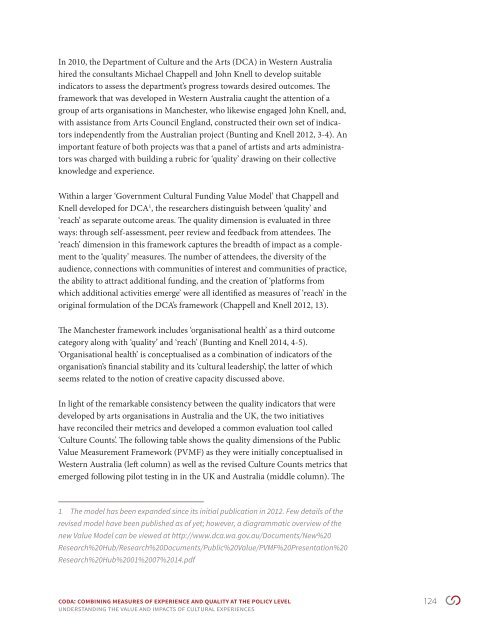aceUVi
aceUVi
aceUVi
You also want an ePaper? Increase the reach of your titles
YUMPU automatically turns print PDFs into web optimized ePapers that Google loves.
In 2010, the Department of Culture and the Arts (DCA) in Western Australia<br />
hired the consultants Michael Chappell and John Knell to develop suitable<br />
indicators to assess the department’s progress towards desired outcomes. The<br />
framework that was developed in Western Australia caught the attention of a<br />
group of arts organisations in Manchester, who likewise engaged John Knell, and,<br />
with assistance from Arts Council England, constructed their own set of indicators<br />
independently from the Australian project (Bunting and Knell 2012, 3-4). An<br />
important feature of both projects was that a panel of artists and arts administrators<br />
was charged with building a rubric for ‘quality’ drawing on their collective<br />
knowledge and experience.<br />
Within a larger ‘Government Cultural Funding Value Model’ that Chappell and<br />
Knell developed for DCA 1 , the researchers distinguish between ‘quality’ and<br />
‘reach’ as separate outcome areas. The quality dimension is evaluated in three<br />
ways: through self-assessment, peer review and feedback from attendees. The<br />
‘reach’ dimension in this framework captures the breadth of impact as a complement<br />
to the ‘quality’ measures. The number of attendees, the diversity of the<br />
audience, connections with communities of interest and communities of practice,<br />
the ability to attract additional funding, and the creation of ‘platforms from<br />
which additional activities emerge’ were all identified as measures of ‘reach’ in the<br />
original formulation of the DCA’s framework (Chappell and Knell 2012, 13).<br />
The Manchester framework includes ‘organisational health’ as a third outcome<br />
category along with ‘quality’ and ‘reach’ (Bunting and Knell 2014, 4-5).<br />
‘Organisational health’ is conceptualised as a combination of indicators of the<br />
organisation’s financial stability and its ‘cultural leadership’, the latter of which<br />
seems related to the notion of creative capacity discussed above.<br />
In light of the remarkable consistency between the quality indicators that were<br />
developed by arts organisations in Australia and the UK, the two initiatives<br />
have reconciled their metrics and developed a common evaluation tool called<br />
‘Culture Counts’. The following table shows the quality dimensions of the Public<br />
Value Measurement Framework (PVMF) as they were initially conceptualised in<br />
Western Australia (left column) as well as the revised Culture Counts metrics that<br />
emerged following pilot testing in in the UK and Australia (middle column). The<br />
1 The model has been expanded since its initial publication in 2012. Few details of the<br />
revised model have been published as of yet; however, a diagrammatic overview of the<br />
new Value Model can be viewed at http://www.dca.wa.gov.au/Documents/New%20<br />
Research%20Hub/Research%20Documents/Public%20Value/PVMF%20Presentation%20<br />
Research%20Hub%2001%2007%2014.pdf<br />
CODA: COMBINING MEASURES OF EXPERIENCE AND QUALITY AT THE POLICY LEVEL 124<br />
UNDERSTANDING the value and impacts of cultural experiences


